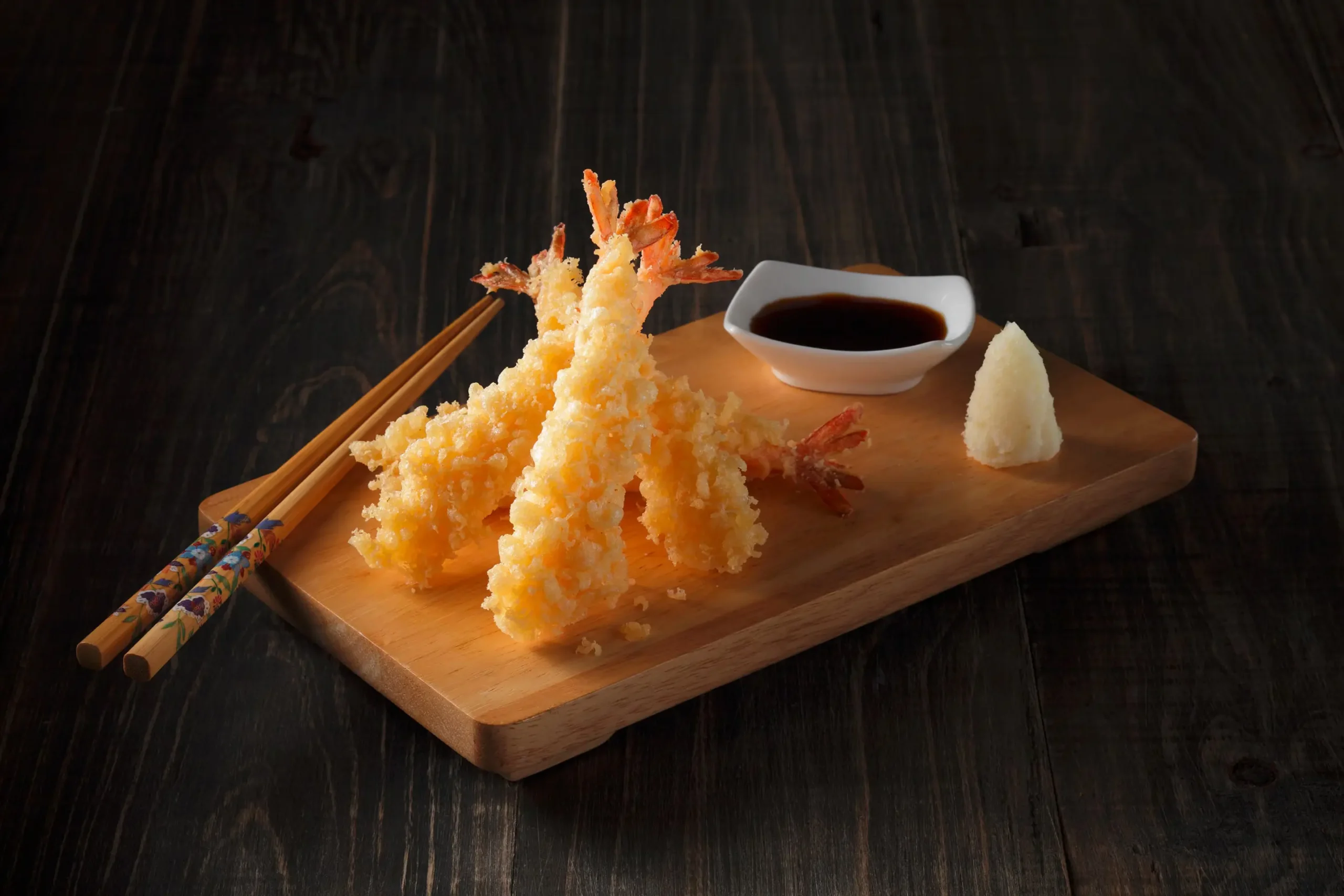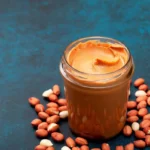
Tempura is a beloved Japanese dish known for its light, crispy batter and a variety of ingredients, typically seafood and vegetables. Originating in the 16th century, tempura has evolved into a popular culinary staple both in Japan and around the world. Its versatility allows for a range of preparations, from traditional shrimp tempura to innovative tempura rolls found in sushi restaurants. With its rich cultural significance and delicious flavor, tempura continues to captivate food enthusiasts, making it a must-try for anyone exploring Japanese cuisine.
Origin: Tempura was introduced to Japan by Portuguese missionaries and traders in the 16th century, specifically during the Nanban trade period. The Portuguese brought with them various culinary techniques and ingredients, one of which was the practice of deep-frying food. Initially, the method was used for preparing fish and vegetables, which resonated with Japanese culinary traditions. Over time, this technique was adapted and refined by Japanese cooks, leading to the creation of what we now recognize as tempura. The incorporation of local ingredients and flavors transformed tempura into a unique dish that is deeply rooted in Japanese cuisine.
Name Etymology: The term “tempura” is believed to be derived from the Latin word “tempora,” which refers to the times of Lent when Catholics would abstain from eating meat. During this period, the Portuguese would consume fried fish and vegetables, a practice that eventually made its way to Japan. The name reflects the dish’s origins and the cultural exchange that occurred between the Portuguese and Japanese. This etymological connection highlights how culinary practices can transcend cultural boundaries and evolve into something distinct and cherished in a new context.
Cooking Technique: Traditional tempura is characterized by its unique cooking technique, which involves lightly battering and deep-frying a variety of vegetables and seafood. The batter is made from a simple mixture of cold water and flour, sometimes with the addition of egg, which contributes to the light and crispy texture that tempura is known for. The key to perfect tempura lies in the frying method; the food is cooked quickly at high temperatures, allowing it to retain its moisture while achieving a golden, crunchy exterior. This technique not only enhances the flavors of the ingredients but also results in a visually appealing dish.
Batter Composition: The batter used for tempura is typically made from cold water, flour, and occasionally egg. The use of cold water is crucial, as it helps to create a light and airy batter that fries up crisp. The flour used is often a low-protein variety, which minimizes gluten formation and contributes to the delicate texture. Some variations of tempura batter may include cornstarch or baking powder to further enhance the crispiness. The balance of ingredients is essential; too much batter can overwhelm the ingredients, while too little can result in a soggy texture. The goal is to achieve a thin coating that allows the natural flavors of the vegetables and seafood to shine through.
Oil Temperature: The ideal frying temperature for tempura is between 160°C to 180°C (320°F to 356°F). Maintaining this temperature is critical for achieving the perfect texture and flavor. If the oil is too hot, the batter may burn before the inside is cooked, resulting in an unpleasant taste and texture. Conversely, if the oil is not hot enough, the batter will absorb excess oil, leading to greasy tempura. Experienced cooks often test the oil temperature by dropping a small amount of batter into the oil; if it sizzles and rises to the surface, the oil is ready for frying. This precision in temperature control is a hallmark of skilled tempura preparation.
Cooking Time: Tempura is typically cooked for about 2 to 3 minutes, depending on the ingredients being used. The quick cooking time is a hallmark of the tempura technique, allowing the food to maintain its natural flavors and textures. For example, delicate vegetables like zucchini or asparagus may require less time, while denser ingredients like sweet potatoes might need a bit longer. The cooking process is visually striking, as the batter puffs up and turns golden brown. This rapid frying not only enhances the taste but also preserves the vibrant colors of the ingredients, making tempura an attractive dish to serve.
Common Ingredients: Popular tempura ingredients include shrimp, sweet potatoes, bell peppers, and green beans. These ingredients were chosen for their ability to maintain their structure and flavor during the frying process. Shrimp tempura is particularly beloved for its tender, juicy texture, while sweet potato tempura offers a subtle sweetness that contrasts beautifully with the crisp batter. Seasonal vegetables are often used to showcase the best of what is available, leading to a diverse array of flavors and textures in each dish. The choice of ingredients can vary by region and season, reflecting the local culinary traditions and preferences.
Tokyo Style: Edo-style tempura, originating in Tokyo, is known for its emphasis on fresh seafood and is often served with a dipping sauce called tentsuyu. This style of tempura emerged in the bustling streets of Edo (modern-day Tokyo) during the Edo period, where it became a popular street food. The focus on fresh, high-quality ingredients is a defining characteristic of Edo-style tempura, with chefs often selecting the best catches of the day. Tentsuyu, the accompanying sauce, is made from dashi (a Japanese soup stock), soy sauce and mirin (a sweet rice wine), creating a savory and slightly sweet dipping sauce that complements the delicate flavors of the tempura. The combination of fresh seafood and the light, crispy batter exemplifies the artistry of Edo-style tempura, making it a favorite among both locals and visitors. The dish is often served with grated daikon radish, which adds a refreshing contrast to the rich flavors of the fried ingredients.
First Tempura Restaurant: The first recorded tempura restaurant in Japan, called “Yasuda,” opened in 1830 in the Nihonbashi district of Tokyo. This establishment marked a significant point in the history of tempura, as it transitioned from a street food to a more formal dining experience. Yasuda became known for its high-quality tempura, attracting patrons who appreciated the skill and care involved in its preparation. The restaurant’s success paved the way for other tempura restaurants to emerge, leading to the establishment of a culinary tradition that would evolve over the years. Today, tempura is celebrated not only in Japan but also around the world as a symbol of Japanese cuisine.
Tempura in the U.S.: Tempura gained popularity in the United States in the 1970s, becoming a staple in Japanese cuisine. As Japanese restaurants began to proliferate in major cities, tempura was embraced by American diners for its unique texture and flavor. The dish’s appeal lies in its versatility; it can be served as an appetizer or as part of a main course, often paired with sushi or rice. The introduction of tempura to American cuisine also led to creative adaptations, such as tempura rolls, which feature tempura-fried shrimp or vegetables wrapped in sushi rice and seaweed. This fusion of flavors and techniques has contributed to the enduring popularity of tempura in the U.S., where it continues to be enjoyed by a diverse audience.
Tempura Variations: There are many regional variations of tempura across Japan, including Katsuura-style and Aichi-style tempura. Each region has its own unique take on the dish, influenced by local ingredients and culinary traditions. For example, Katsuura-style tempura, originating from the Katsuura area in Chiba Prefecture, is known for its emphasis on fresh seafood, particularly fish caught from the nearby ocean. Aichi-style tempura, on the other hand, often features a variety of seasonal vegetables and may incorporate a thicker batter. These regional differences highlight the adaptability of tempura, allowing it to evolve while still retaining its core characteristics. As a result, tempura can be experienced in diverse ways throughout Japan, each offering a distinct flavor profile and presentation.
Tempura Flour: Special tempura flour, often made with a blend of wheat flour and cornstarch, is available for achieving the perfect batter. This specific flour is designed to create a lighter and crispier texture compared to regular all-purpose flour. The inclusion of cornstarch helps to reduce gluten formation, which is essential for maintaining the delicate structure of the batter. Many chefs prefer using tempura flour because it allows for a more consistent frying result, ensuring that each piece of tempura is uniformly crispy. Some brands even offer pre-mixed tempura flour that simplifies the cooking process for home cooks, making it easier to replicate the restaurant-quality texture at home.
Tempura Sauce: Tentsuyu, the traditional dipping sauce for tempura, is made from dashi, soy sauce, and mirin. Dashi is a fundamental component of Japanese cuisine, typically made from kombu (seaweed) and bonito flakes (dried fish flakes), which impart a rich umami flavor to the sauce. The addition of soy sauce provides saltiness, while mirin adds a subtle sweetness that balances the flavors. Tentsuyu is often served warm or at room temperature, enhancing the overall dining experience. Some variations may include grated daikon radish or ginger to add freshness and complexity to the sauce. This simple yet flavorful accompaniment elevates the tempura, allowing diners to enjoy the contrast between the crispy batter and the savory dipping sauce.
Tempura and Sake: Tempura is often paired with sake, a traditional Japanese rice wine, enhancing the dining experience. The light and crispy nature of tempura complements the delicate flavors of sake, creating a harmonious balance on the palate. Sake comes in various types, ranging from sweet to dry, and the choice of sake can significantly influence the overall taste of the meal. When pairing tempura with sake, many diners opt for junmai or ginjo varieties, which offer a clean and crisp finish. The cultural practice of enjoying sake with tempura not only highlights the flavors of both but also reflects the Japanese philosophy of appreciating food and drink in unison, enhancing the overall enjoyment of the dining experience.
Tempura Festivals: The Katsuura Seafood Festival in Chiba Prefecture celebrates tempura with various seafood dishes every October. This annual event attracts visitors from all over Japan and beyond, showcasing the region’s rich seafood offerings and culinary traditions. During the festival, local chefs prepare a wide array of tempura dishes, featuring fresh catches from the nearby ocean. Attendees can sample different types of tempura, participate in cooking demonstrations, and enjoy live entertainment. The festival serves as a platform for promoting local seafood and the art of tempura, fostering a sense of community and appreciation for Japanese cuisine. It also highlights the seasonal aspect of tempura, as chefs create dishes that reflect the best ingredients available at that time of year.
Health Aspect: Tempura is generally lighter than other fried foods due to the quick cooking method and the use of less batter. The rapid frying process allows the ingredients to cook quickly, which helps to retain their natural moisture and nutrients. Unlike heavier fried foods that are often soaked in oil, tempura is characterized by its light, crispy coating, which minimizes the amount of oil absorbed during cooking. This makes tempura a more health-conscious option for those looking to enjoy fried foods without the excess calories and fat. Additionally, the use of fresh vegetables and seafood in tempura contributes to a balanced meal, providing essential vitamins and minerals while still satisfying cravings for crispy textures.
Shrimp Tempura: Shrimp tempura, known as “ebi tempura” in Japanese, is one of the most celebrated variations of this dish. Typically made with large, succulent shrimp, it is characterized by its light, crispy batter that allows the natural sweetness of the shrimp to shine through. The shrimp is often deveined and lightly coated in a tempura batter made from cold water, flour, and sometimes egg, which results in a delicate crunch when fried. This dish is commonly served with a dipping sauce called tentsuyu, made from dashi, soy sauce, and mirin, enhancing the flavor profile and offering a delightful contrast to the crispy texture.
Tempura in Fine Dining: In high-end restaurants, tempura is elevated beyond its traditional roots, often featuring gourmet ingredients that reflect seasonal availability and culinary creativity. Chefs may incorporate luxurious items such as truffles, which add an earthy aroma and rich flavor, or seasonal vegetables like asparagus and lotus root, which are lightly battered and fried to perfection. The presentation is also key in fine dining, where tempura may be served artistically arranged on a plate, accompanied by delicate garnishes and sauces that enhance the dining experience, making it not just a meal but a culinary art form.
Tempura Cooking Class: Tempura cooking classes have become a popular activity for tourists visiting Japan, where they can immerse themselves in the culinary traditions of the country. These classes typically guide participants through the entire process of making tempura, from selecting the freshest ingredients to mastering the technique of frying. Participants learn about the importance of temperature control, the right batter consistency, and the best practices for frying to achieve that signature light and crispy texture. These hands-on experiences not only provide valuable cooking skills but also offer insights into Japanese culture and cuisine.
Tempura Roll: In sushi restaurants, tempura rolls have gained popularity as a fusion dish that combines the principles of sushi with the delightful crunch of tempura. These rolls often feature tempura shrimp or vegetables wrapped in sushi rice and nori (seaweed), creating a harmonious blend of flavors and textures. The tempura adds a satisfying crunch that contrasts beautifully with the soft rice and the umami of the nori. Many variations exist, with some rolls incorporating additional ingredients like avocado or spicy mayo, making them a favorite among sushi lovers seeking a unique dining experience.
Largest Tempura: The record for the largest tempura ever made is an impressive feat, weighing over 100 kg (220 lbs). This monumental dish was created during a festival in Japan, showcasing not only the skill and teamwork of the chefs involved but also the cultural significance of tempura in Japanese cuisine. Such events often draw large crowds, as they celebrate culinary creativity and community spirit. The enormous tempura is typically made using a variety of ingredients, and its preparation can become a spectacle, attracting attention from both locals and tourists alike.
Tempura in Pop Culture: Tempura has made its mark in various aspects of Japanese pop culture, particularly in anime and manga, where it is often depicted as a beloved comfort food. Characters in these stories are frequently shown enjoying tempura during meals, highlighting its status as a staple in Japanese households. This portrayal not only emphasizes the dish’s popularity but also reflects the cultural significance of food in bringing people together and creating shared experiences. The inclusion of tempura in pop culture helps to promote its recognition and appreciation beyond Japan’s borders.
Cost of Tempura: The cost of tempura can vary significantly depending on the dining establishment and the quality of the ingredients used. In high-end restaurants, a tempura dish can range from $15 to $50, influenced by factors such as the type of seafood or vegetables used, the chef’s expertise, and the overall dining experience. Dishes featuring premium ingredients, such as fresh seafood or organic vegetables, may command higher prices. This price range reflects the meticulous preparation and presentation that goes into creating an exquisite tempura experience, making it a sought-after item for those looking to indulge in gourmet Japanese cuisine.
Tempura and Allergies: When serving tempura, it is crucial to consider common allergens that may affect diners. The batter used in tempura typically contains gluten, as it is made from wheat flour, which can pose a problem for those with gluten sensitivities or celiac disease. Additionally, shrimp tempura contains shellfish, which is a common allergen for many individuals. Restaurants often take these considerations seriously, providing alternative options for those with dietary restrictions and ensuring that proper precautions are taken to avoid cross-contamination, allowing everyone to enjoy this delicious dish safely.
Tempura and Sustainability: In recent years, many restaurants have begun to focus on sourcing local and seasonal ingredients for their tempura offerings, promoting sustainability within the culinary industry. By prioritizing local produce and seafood, chefs can reduce their carbon footprint while supporting local farmers and fisheries. This approach not only enhances the freshness and flavor of the tempura but also aligns with growing consumer demand for environmentally responsible dining options. Many establishments highlight their commitment to sustainability by featuring seasonal menus that change throughout the year, showcasing the best ingredients available at any given time. This trend encourages diners to appreciate the connection between their food and the environment, fostering a greater awareness of sustainable practices in the culinary world.
Tempura FAQs
What is Tempura?
Tempura is a Japanese dish consisting of seafood and vegetables that have been dipped in a light batter and deep-fried. It’s characterized by its crispy exterior and tender interior. The key to perfect tempura is a light, airy batter and high-quality oil.
What are the Common Ingredients for Tempura?
While there’s a wide variety of ingredients used for tempura, some of the most common include:
- Seafood: Shrimp (ebi), white fish, squid
- Vegetables: Eggplant, sweet potato, pumpkin, green beans, onion, shiitake mushrooms
- Other: Asparagus, green peppers, lotus root
What Makes Tempura Batter Different?
Tempura batter differs from other batters in a few key ways:
- Lightness: It’s significantly lighter and airier due to the use of cold water and minimal mixing.
- Ingredients: Typically only flour, eggs, and cold water are used.
- No seasonings: The batter itself is usually not seasoned to allow the flavor of the ingredients to shine.
How to Make Crispy Tempura?
Achieving crispy tempura involves several factors:
- Cold batter: Using cold water prevents gluten development, resulting in a lighter batter.
- Dry ingredients: Ensure the ingredients are thoroughly dried before battering to prevent excess moisture.
- Hot oil: The oil temperature should be around 350-375°F (175-190°C) for optimal crispiness.
- Quick frying: Overcrowding the frying pan can lower the oil temperature, so fry in small batches.
- Draining: Allow the tempura to drain on a paper towel-lined rack to remove excess oil.
What to Serve with Tempura?
Tempura is traditionally served with a dipping sauce called tempura sauce or tensuyu. This sauce is typically made with soy sauce, mirin, and dashi. Some people also enjoy tempura with grated daikon radish and grated ginger.
Can You Reheat Tempura?
While not ideal, you can reheat tempura. The best method is to reheat it in a very hot oven or air fryer to regain some crispiness. However, the texture will never be as good as freshly made tempura.
Tempura vs. Furai
Tempura and furai are both deep-fried Japanese dishes, but they differ in batter and ingredients. Tempura uses a light batter without breadcrumbs, while furai uses a thicker batter and often breadcrumbs.









